
Industrial area in Kalimantan. Photo courtesy of Stanislav Lhota.
The proposed extension of an industrial area in East Kalimantan, Indonesia will likely mean the end of a population of rehabilitated orangutans who reside there, according to the Indonesian environmental group Peduli Teluk Balikpapan. The Kariangau Industrial Area (KIK) will comprise 5,130 hectares of land currently covered by hardwood forests and mangroves when completed, including one third of orangutan habitat in Sungai Wain forest—a crucial portion that is not within the boundaries of the Sungai Wain Protection Forest and therefore not under any governmental protection. Though the expansion has not yet been finalized, two companies—PT Dermaga Kencana Indonesia (Kencana Agri Ltd. Group) and PT Mekar Bumi Andalas (Wilmar Group)—have proceeded to clear forest and reclaim mangrove swamps in areas still classified as protected in order to build crude palm oil mills near Upper Balikpapan Bay.
The Sungai Wain orangutans are part of a rehabilitation program established by the Borneo Orangutan Survival Foundation in the 1990s. Over 80 orangutans have been released into the surrounding primary and secondary forests, including the famous orphaned orangutan Uce. However the population is already imperiled by orangutan killing.
“The orangutan population in Sungai Wain has been well established and almost all females are now being accompanied by one or two infants or juveniles,” Dr. Stanislav Lhota, a primatologist and researcher who works with Peduli Teluk Balikpapan, told mongabay.com. “Given this, it is surprising that the total size of the population is just 15-30 individuals, based on our survey of large mammals in and around Sungai Wain in 2006. Although several of the 80-plus orangutans released in Sungai Wain were translocated to Gunung Meratus following the forest fires in 1998, we strongly believe that most of the population disappeared due to opportunistic killing by local people as the animals move out of the forest into encroachment zones along its southern and northern boundaries.”
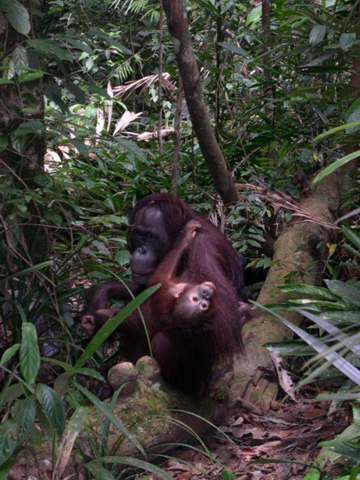 Orangutans, Uce and Bulan. Photo courtesy of Stanislav Lhota. |
One of the reasons Lhota cites for opportunistic hunting are secondary roads that make Sungai Wain accessible.
“Whenever there is a development (big roads, plantations or industry), there is a network of smaller roads going far into the forests. The roads are often created with the primary purpose of land speculations but they are also frequented by hunters,” he says, adding that, “the local people do not target orangutans for hunting but given the opportunity, they may kill them.”
Though Lhota notes that Sungai Wain Protection Forest is relatively well protected by patrols, one third of the orangutan’s habitat is not within the boundaries.
“The animals apparently depend on the unprotected area and move frequently between the protected and unprotected forest,” Lhota explains, adding that in the unprotected forest, “there is no wildlife protection at all.”
Increased hunting is only part of the problem with the expansion. Development from the expansion of the KIK would destory 20 percent of the orangutan habitat Lhota said in a press statement.
“The total loss (due to development and resulting encroachment) would be more than 1/3 of the available habitat, based on the experience from the eastern boundaries where the encroachment zone extends to more than 2 kilometers into the forest, and continues to expand even now, despite intensive patrolling by forest guards, police and army, and the legislation, which includes a local decree, which strictly prohibits access to the major part of the Protection Forest.”
Because of encroachment and increased hunting pressure, the rehabilitated Sungai Wain orangutans may be lost in as little as one to two decades.
Indonesian Lowlands (on the Island of Borneo) are already “badly affected by logging, forest fires, and fire conversion into agriculture, tree plantation, mining and industry,” according to Lhota.
The proposed expansion of KIK may also mean the collapse of fisheries, bay silting, decline in biodiversity and loss of reputation for the region. The NGO, Peduli Teluk Balikpapan, contends that there are several design flaws in the KIK expansion which could have serious ecological and economic consequences. For example, while Balikpapan Bay is a closed seawater system “most of the freshwater flow that enters the bay from the coastal areas will not be ‘flushed’ into the open waters of the Makasser Strait,” the organization writes in a press release, “instead, [the water] will be blocked and moved back upstream by incoming tides. Thus any sediment and industrial waste will accumulate in the waters of the upper section of the bay where it will settle. In the long term, this would lead to extreme levels of sedimentation and accumulation of dangerous pollutants.”
The fishing industry, a major source of income for the residents of the area, could be threatened if unskilled laborers are unable to get a job working with one of the new companies along the coast. Those that are able to continue fishing must be wary of pollutants and other waste resulting from the industry along with any possible coastal damage.
Because Borneo contains the largest amount of contiguous forest in Asia, there is an enormous amount of endemism in plants and animals. The expansion of industry may result in the loss of not only orangutan populations but numerous protected species living in the forest and the coastal waters. One of these species could be the proboscis monkey, according to Lhota.
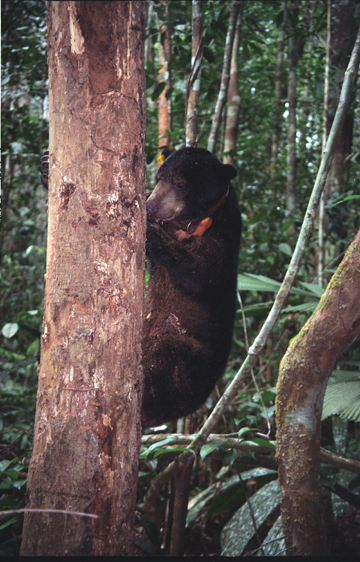 Sun bear (Helarctos malayanus) breaking into a bee’s nest in Sungai Wain Protection Forest. This species is listed as Vulnerable by the IUCN Red List. Photo courtesy of Stanislav Lhota. |
“The population of proboscis monkeys in the Bay was about 1400 according to the 2007 survey. It is one of the 7 known populations of more than 1000 and it may be as much as 5% of the total viable population of the species,” he says.
According to Peduli Teluk Balikpapan, there are 1,000 species of trees, around 300 species of birds and more than 100 species of animals living in the area. If land is converted for residential or industrial use, many of these unique species could be lost, as numbers are already threatened by industrial development and climate change.
“In the case of the orangutans it is a rather moral issue,” Lhota adds. “The current numbers in Sungai Wain and their extinction will probably not affect the survival of the whole species. But the population is a result of an ex-captive rehabilitation program, which cost considerable effort and which was supported by many people. I believe that the future of such populations needs to be safeguarded, and it should be a shared responsibility of anyone who is involved in orangutan conservation and rehabilitation. Orangutan rehabilitation would have little meaning if the newly established population is later abandoned and their habitat is left to be allocated for conversion into industry or other use.”
NGOs have further criticized the KIK’s claims, saying their proposals are guilty of greenwashing in order to influence residents that the expansion will have a positive impact on the environment. Critics claim that by using buzzwords and concepts like “Zero Sediment,” “Zero Waste,” the “Green Line (Green Corridor)” and “Foresting the City,” KIK is attempting to subdue arguments from environmental groups. Claims such as “Zero Sediment” and “Zero Waste” can be misleading since there are no ways to guarantee zero sedimentation or waste.
According to the NGO’s reports, coral reefs around the area have already been severely damaged by layers of mud from construction, to the end that more than 50% of them are dead. The proposed Green Corridor has already been extensively damaged by clearing, and the company’s promise to “Forest the City” by replanting mangroves has been deemed unnecessary in areas where mangroves are able to regenerate naturally and does not replace the damage being done to the coastlines and forests outside of the city.
Furthermore, Peduli Teluk Balikpapan argues that the expansion of KIK is not being done for the sake of economic development but rather for land speculations.
“Since the 1990s, people (apparently including some influential people) were buying the forested land around Sungai Wain Protection Forest and Balikpapan Bay for negligible prices (as little as 1-2 million Indonesian Rupees per hectare),” says Lhota. “By lobbying for development of the area, such as the proposed construction of Trans Kalimantan Highway towards the Balang Island or the proposed extension of the Kariangau Industrial Area, they can assure that the prices of the same land may rocket up to 20-30 million per hectare or even more, and they are now selling this land to various corporations, mainly to the highly environmentally irresponsible ones.”
Lhota suggests two alternative areas for the industrial area that he says would be better both for the environment and the economy: either the boundary of Balikpapan and Samboja (Kutai Kartanegara Regency), or the Penajam-Buluminung Area (Penajam Paser Utara Regency).
“Both are flat areas in lower (instead of upper) watershed, completely deforested with better infrastructure,” he says, adding that, “[A] third option is taking better advantage of the existing 2000 hectares of the Kariangau Industrial Area, which is a degraded wasteland that can still be developed, without the real need of the extension in to forested areas.”
Although not necessary to save the species, the extinction of these rehabilitated orangutan would be a serious loss for orangutan conservation efforts everywhere.
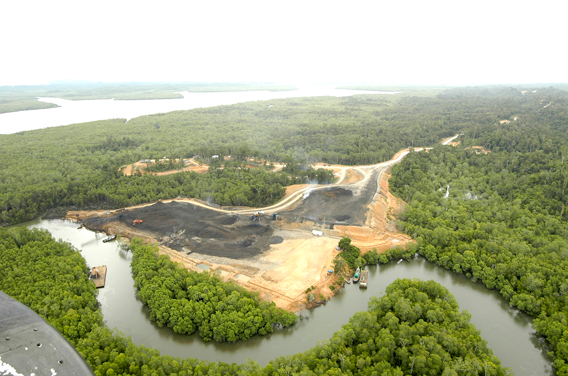
Coal loading site in Balikpapan Bay area. Photo courtesy of Stanislav Lhota.
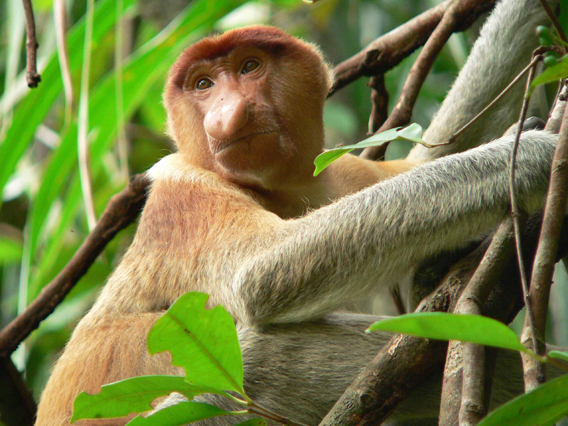
Proboscis monkey. Photo courtesy of Stanislav Lhota.

Mangrove forest in Sungai Lob. Photo courtesy of Stanislav Lhota.
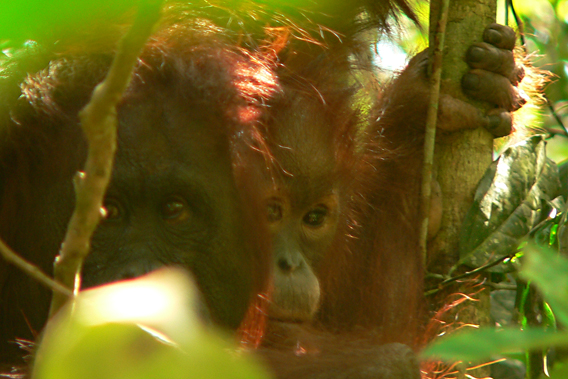
Imperiled orangutans near Sungai Wain Protection Forest. Photo courtesy of Stanislav Lhota.
Related articles
90 percent of oil palm plantations came at expense of forest in Kalimantan

(10/08/2012) From 1990 to 2010 almost all palm oil expansion in Kalimantan came at the expense of forest cover, according to the most detailed look yet at the oil palm industry in the Indonesian state, published in Nature: Climate Change. Palm oil plantations now cover 31,640 square kilometers of the state, having expanded nearly 300 percent since 2000. The forest loss led to the emission of 0.41 gigatons of carbon, more than Indonesia’s total industrial emissions produced in a year. Furthermore the scientists warn that if all current leases were converted by 2020, over a third of Kalimantan’s lowland forests outside of protected areas would become plantations and nearly quadruple emissions.
Burning forests in Southeast Asia increases mortality rates in the region

(08/13/2012) Clearing forests and other vegetation with fire in Southeast Asia can kill, according to a new study in Nature Climate Change. The research found that fire-induced air pollution, including fine particulates and a rise in ozone, could be linked to thousands of deaths during El Nino years when dry conditions worsen human-set fires. The pollution was found to be worst over Malaysia and Indonesia, the latter where the vast majority of the fires are set.
Indonesia to investigate palm oil company’s alleged breach of deforestation moratorium
(07/23/2012) Indonesia’s top official charged with implementing the country’s moratorium on new concessions in peatlands and primary forest areas is calling for an investigation into alleged violations by a palm oil company operating in Central Kalimantan, reports the REDD+ Task Force.
Borneo’s forests face dire future from global warming
(07/18/2012) Already wracked by extensive deforestation and forest degradation, the future looks grim for Borneo’s tropical rainforests, reports a new study published in the Journal of Geophysical Research-Biogeosciences.
Industrial logging leaves a poor legacy in Borneo’s rainforests

(07/17/2012) For most people “Borneo” conjures up an image of a wild and distant land of rainforests, exotic beasts, and nomadic tribes. But that place increasingly exists only in one’s imagination, for the forests of world’s third largest island have been rapidly and relentlessly logged, burned, and bulldozed in recent decades, leaving only a sliver of its once magnificent forests intact. Flying over Sabah, a Malaysian state that covers about 10 percent of Borneo, the damage is clear. Oil palm plantations have metastasized across the landscape. Where forest remains, it is usually degraded. Rivers flow brown with mud.
Charts: deforestation in Indonesia and Malaysia, 2000-2010

(07/15/2012) Indonesia and Malaysia lost more than 11 million hectares (42,470 square miles) of forest between 2000 and 2010, according to a study published last year in the journal Global Change Biology. The area is roughly the size of Denmark or the state of Virginia. The bulk of forest loss occurred in lowland forests, which declined by 7.8 million hectares or 11 percent on 2000 cover. Peat swamp forests lost the highest percentage of cover, declining 19.7 percent. Lowland forests have historically been first targeted by loggers before being converted for agriculture. Peatlands are increasingly converted for industrial oil palm estates and pulp and paper plantations.
Building indigenous resilience in the face of land-grabbing, deforestation in Malaysian Borneo

(07/10/2012) In the 1980s images of loincloth-clad tribesmen blockading blocking logging roads in Malaysian Borneo shocked the world. But while their protests captured the spotlight momentarily, Borneo’s forests continued to be destroyed at rapid rates, undermining traditional communities that are dependent on these ecosystems for food, shelter, medicine, clean water, and spiritual inspiration. Nomadic tribes are now but a memory in Borneo, but other tribal groups continue to fight for their forests by seeking legal recognition of their lands and blocking destructive projects, including oil palm plantations, logging operations, and large-scale hydroelectric projects. Helping them is The Borneo Project, a Berkeley-based non-profit that works in partnership with indigenous communities and the small non-profits that support them.
Palm oil is a major driver of peatlands destruction in Indonesian Borneo, finds new study
(04/27/2012) Developers in Indonesian Borneo are increasingly converting carbon-dense peatlands for oil palm plantations, driving deforestation and boosting greenhouse gas emissions, reports a new study published in Proceedings of the National Academy of Sciences. The research concludes that nearly all unprotected forests in Ketapang District in West Kalimantan will be gone by 2020 given current trends.